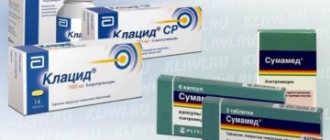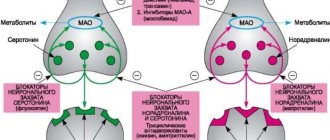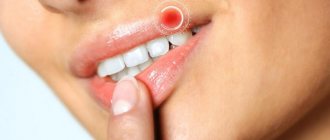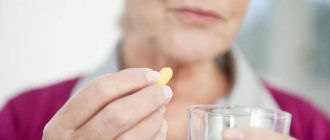Release form and composition
Dosage forms of Nootropil:
- solution for intravenous (i.v.) and intramuscular (i.m.) administration: clear, colorless liquid (in ampoules of 15 ml, 4 ampoules in plastic trays, 4 pallets in a cardboard box; in ampoules of 5 ml, 6 ampoules per plastic pallet, 2 pallets in a cardboard box);
- oral solution 33%: colorless liquid of thick consistency (125 ml in dark glass bottles, 1 bottle in a cardboard box complete with a measuring cup);
- film-coated tablets: oblong, almost white or white, with a dividing transverse score on both sides, on one side - engraving “N” to the right and left of the score (dosage 1.2 g: 10 pcs. in blisters, in cardboard pack 2 blisters; dosage 0.8 g: 15 pieces in blisters, 2 blisters in a cardboard pack);
- oral solution: clear, colorless liquid (125 ml in dark glass bottles, 1 bottle in a cardboard box complete with a measuring cup);
- capsules: gelatin, white cap and body, marked “ucb” and “N”, capsule contents – white powder (15 pcs. in blisters, 4 blisters in a cardboard box).
1 ml of solution for intravenous and intramuscular administration contains:
- active ingredient: piracetam – 0.2 g;
- auxiliary components: glacial acetic acid, sodium acetate trihydrate, water for injection.
1 ml of 33% oral solution contains:
- active ingredient: piracetam – 0.33 g;
- auxiliary components: sodium saccharin, glycerol, propyl hydroxybenzoate, methyl parahydroxybenzoate, caramel flavor, apricot flavor, sodium acetate, glacial acetic acid, water.
1 tablet contains:
- active ingredient: piracetam – 0.8 g or 1.2 g;
- auxiliary components: macrogol 6000, silicon dioxide, croscarmellose sodium, magnesium stearate;
- shell: opadry OY-S-29019 [hypromellose 2910 50cP, macrogol 6000]; opadry Y-1-7000 [titanium dioxide (E171), hypromellose 2910 5cP (E464), macrogol 400].
1 ml of oral solution contains:
- active ingredient: piracetam – 0.2 g;
- auxiliary components: propyl parahydroxybenzoate, glycerol 85%, methyl parahydroxybenzoate, sodium saccharinate, glacial acetic acid, apricot flavor, sodium acetate, caramel flavor, purified water.
1 capsule contains:
- active ingredient: piracetam – 0.4 g;
- auxiliary components: lactose monohydrate, colloidal silicon dioxide, macrogol 6000, magnesium stearate;
- capsule shell: titanium dioxide (E171), gelatin.
General information about Nootropil
Nootropil is a medicinal drug that has nootropic, neuroprotective and antihypoxic properties. It is produced by a well-known pharmaceutical company from Belgium.
Dosage form, INN, scope of application
The drug Nootropil belongs to a large group of drugs - nootropics or neurometabolic stimulants. Such drugs affect the brain, stimulating higher mental functions.
The international nonproprietary name is determined by the content of the active substance in the drug, which affects the human body in one way or another.
INN Nootropil - Piracetam. Such drugs are used in neurological and psychiatric practice to treat cognitive disorders. It is prescribed to adults, elderly patients (including those with Alzheimer's disease), as well as children.
Release form, cost
The drug is presented on pharmacy counters in various pharmacological forms. They have their own characteristics:
- Pills. They have an oblong capsule-like shape and are white in color. On one side of the tablet there is an engraving - the Latin letter N. They are packaged in aluminum foil blisters of 10 or 15 pieces. In total, a cardboard box contains 20 or 30 tablets.
- Capsules for oral use. On top there is a white capsule shell, inside of which there is a white crystalline powder. There is an engraving (N) on the surface of the capsule. They are packaged in blisters of 15 pieces. The box contains 4 blisters (60 capsules).
- Syrup for oral administration. It is a clear, thick, colorless liquid that has a sweet taste and caramel odor. This syrup is placed in a 125 ml glass bottle. It also comes with a plastic measuring cup.
- Injection solution. It is placed in glass ampoules of 5 or 15 ml. The package contains 4 or 12 ampoules.
What determines how much a drug costs? Its price is determined by the form of release, the content of the active substance, and the number of tablets in the package. The cost is also affected by where the medicine is purchased. Examples of prices in different pharmacies in Russian cities:
| Medicine | Pharmacy, city | Cost in rubles |
| Nootropil 1200 mg, No. 20 (20 pieces) | BALTIKA-MED, St. Petersburg | 265 |
| Nootropil 800 mg (30 tablets) | BALTIKA-MED, St. Petersburg | 285 |
| Nootropil solution for intravenous or intramuscular administration 20% (12 ampoules of 5 ml) | Online pharmacy "DIALOG", Moscow and region | 250 |
| Nootropil syrup 20% (125 ml) | Online pharmacy "DIALOG", Moscow and region | 280 |
| Nootropil tablets 1200 mg, No. 20 | Laboratory of beauty and health, Moscow | 206 |
| Nootropil 800 mg, No. 30 | Laboratory of beauty and health, Moscow | 278 |
| Nootropil oral solution 20% (125 ml) | Chain of pharmacies "Be Healthy", St. Petersburg | 340 |
| Nootropil 800 mg, No. 30 | Chain of pharmacies "Be Healthy", St. Petersburg | 287 |
| Nootropil 1200 mg, No. 20 | APTEKA LLC, St. Petersburg | 266 |
Compound
The composition of the drug differs depending on its pharmacological form:
- 1 ampoule with injection solution contains piracetam 200 mg per 1 ml (1 g for a 5 ml ampoule and 3 g for 15 ml). The auxiliary components are: acetic acid, water for injection, sodium acetate trihydrate.
- 1 ml of syrup contains 200 mg of active ingredient. Additional components - glycerol, saccharin and sodium acetate, acetic acid, purified water, methyl and propyl parahydroxybenzoate, flavorings (caramel and apricot).
- 1 capsule contains 400 mg of piracetam, as well as milk sugar, magnesium stearate, aerosil, macrogol 6000. The capsule shell consists almost entirely of gelatin and also contains a small amount of titanium dioxide and water.
- The tablets contain 800 or 1200 mg of piracetam, as well as additionally silicon dioxide, magnesium stearate, croscarmellose and macrogol. The film shell contains the following substances: titanium dioxide, hypromellose, macrogol 400 and macrogol 6000.
Pharmacodynamic and pharmacokinetic properties
The pharmacodynamics of the drug Nootropil depends on the action of its active substance piracetam. It is a cyclic derivative of gamma-aminobutyric acid (GABA). Its mechanism of action on the central nervous system is associated with the following processes:
- influence on the transmission of nerve impulses between brain cells;
- improvement of neuroplasticity due to the effect on metabolic processes;
- improvement of blood microcirculation;
- saturation of the brain with oxygen and nutrients by improving its blood supply;
- improving communication between the right and left hemispheres of the brain;
- preventing platelet aggregation;
- improvement of rheological blood parameters;
- does not cause relaxation of vascular walls.
At the same time, Nootropil has a neuroprotective and restorative effect on the brain damaged due to oxygen starvation, intoxication with alcohol or other toxic substances, or electric shock. Can be used to eliminate myoclonic syndrome due to vestibular neuronitis.
Pharmacokinetic features of piracetam:
- rapid and complete absorption through the digestive organs;
- high bioavailability (more than 99%);
- the highest concentration in the blood develops after half an hour (with intravenous administration) or after 1 hour when taken orally, in the cerebrospinal fluid - after 2-8 hours (when taking a single dose of more than 2 g);
- does not bind to blood proteins and is not metabolized in the liver;
- excreted primarily in urine unchanged;
- can accumulate in brain tissue;
- half-life from the blood lasts about 4 hours, from the cerebrospinal fluid – up to 8 hours (may be prolonged in case of kidney failure).
Piracetam is able to penetrate the blood-brain barrier, as well as the placenta.
See also:
Instructions for use of the Nootropic drug, indications, contraindications and reviews
Pharmacological properties
Pharmacodynamics
The active substance of Nootropil, piracetam, is a cyclic derivative of gamma-aminobutyric acid (GABA). It does not have organ-specific or cell-specific properties; the main mechanism of its action is due to binding to the polar heads of phospholipids and the formation of mobile piracetam-phospholipid complexes. This helps restore the two-layer structure of the cell membrane and its stability, the three-dimensional structure of membrane and transmembrane proteins and their functional properties.
Piracetam has a predominant effect on the density of postsynaptic receptors and their activity, facilitating various types of synaptic transmission at the neuronal level. Without showing a sedative or psychostimulating effect, it causes an improvement in the function of memory, attention, learning and consciousness.
By influencing red blood cells, platelets and vessel walls, it contributes to the positive dynamics of hemorheological parameters. In case of sickle cell anemia, it increases the ability of red blood cells to deform, reduces blood viscosity and prevents the formation of “coin columns”. In addition, without significantly affecting the number of platelets, it reduces their aggregation. Piracetam is able to prevent vasospasm and counteract vasospastic substances. It causes a decrease in the adhesion of red blood cells to the vascular endothelium and stimulates the production of prostacyclins by healthy endothelium.
Pharmacokinetics
There is no information on the pharmacokinetics of the solution for injection.
After taking piracetam orally, it is rapidly and almost completely absorbed from the gastrointestinal tract. The maximum concentration (Cmax) in blood plasma is 0.000084 g/ml with a single dose of 3.2 g. When using Nootropil at a dose of 3.2 g 3 times a day, Cmax in blood plasma reaches 0.000115 g/ml after 1 hour and after 5 hours in the cerebrospinal fluid. Simultaneous food intake reduces Cmax by 17% and increases the time to reach maximum concentration by up to 1.5 hours. When taking a dose of 2.4 g, Cmax in women is 30% higher than in men.
Piracetam does not bind to plasma proteins. The volume of distribution is approximately 0.6 l/kg. Selective accumulation of piracetam in the tissues of the cerebral cortex, mainly in the cerebellum and basal ganglia, parietal, frontal and occipital lobes, has been established.
The substance penetrates the blood-brain and placental barrier, overcomes the filtering membranes of hemodialysis machines. Not metabolized in the body.
Up to 80–100% of the administered dose of piracetam is excreted unchanged through the kidneys by renal filtration. The total clearance is 80–90 ml/min. The half-life (T1/2) does not depend on the route of administration and is 4–5 hours from blood plasma and 8.5 hours from cerebrospinal fluid.
In case of renal failure, T1/2 is prolonged; in case of chronic form of renal failure in the terminal stage, it can be 59 hours.
In case of liver failure, the pharmacokinetics of piracetam does not change.
Clinical and pharmacological group
The medicine belongs to the subgroup of nootropic substances.
Release form, composition and packaging
There are several medication options:
- in a mixture for parenteral use - in ampoules of 15 ml;
- in a mixture for internal use - in darkened glass bottles of 125 ml;
- in tablets - with a dosage of 1.2 grams, 20 units per pack, or 0.8 grams - 30 units per pack;
- in capsules – 60 units per pack.
All forms of the drug include the key ingredient piracetam in varying proportions. Secondary components depend on the manufacturing option of the drug:
- for parenteral administration - sodium salt of acetic acid, ethanoic acid, liquid for injections;
- in oral solution – sodium saccharin, glycerol, Caramel and Apricot flavoring, propyl hydroxybenzoate, sodium salt of acetic acid, methyl parahydroxybenzoate, water, ethanoic acid;
- in tablets - silica, polyethylene glycol, magnesium salt of stearic acid, primelose;
- in capsules - milk sugar, polysorb, magnesium salt of stearic acid, polyethylene glycol.
pharmachologic effect
Piracetam allows you to restore the double structure of the cell membrane, its stable state, which allows you to stabilize the state of transmembrane proteins and restore their functionality.
At the neuronal level, the substance improves synaptic transmission and stabilizes individual functions:
- ability to learn;
- memory indicators;
- concentration.
The drug does not have a psychostimulating or sedative effect. The substance affects vascular walls, platelets and red blood cells. For sickle cell anemia, the medicine increases the ability of red blood cells to change, lowers blood flow viscosity, and prevents the formation of pathology of coin columns. When the level of platelet aggregation decreases, the drug does not affect their number.
Pharmacokinetics
After internal administration, the active ingredient is quickly absorbed from the gastrointestinal tract, its bioavailability reaches almost 100%. Piracetam is able to accumulate in the tissues of the cerebral cortex and easily penetrates the placental and blood-brain barrier.
The substance does not undergo the metabolic process in the body and is not able to bind to protein structures in the blood plasma. The half-life is four to five hours from the bloodstream and 8.5 hours from the cerebrospinal fluid. About 80-100% of the ingredient is excreted through the kidneys in its original form.
The half-life increases in renal failure, and in hepatic failure - all processes proceed as usual.
Indications for use
For adult patients:
- psychoorganic syndrome (in elderly patients inclusive), accompanied by dizziness, memory loss, deterioration in concentration, decreased activity, behavior disorder, mood changes, gait disturbance (these symptoms refer to early signs of age-related diseases such as Alzheimer's disease, senile dementia of Alzheimer's type) – as symptomatic therapy;
- dizziness and associated imbalance (except for psychogenic and vasomotor dizziness) - for treatment;
- cortical myoclonus – as monotherapy or as part of complex therapy;
- Sickle cell vaso-occlusive crisis: tablets, oral solution, capsules - as a prophylaxis, solution for intravenous and intramuscular administration - for treatment.
For children:
- dyslexia: tablets, oral solution, capsules – as part of complex therapy;
- Sickle cell vaso-occlusive crisis: tablets, oral solution, capsules - as a prophylaxis, solution for intravenous and intramuscular administration - for treatment.
In what cases is the drug "Nootropil" used?
Nootropil tablets and injections are a very popular remedy used by doctors for many pathologies. And, judging by the reviews of specialists and patients, this treatment has good results.
- The drug is used in cases of psychoorganic syndrome, which is characteristic mainly of older people and manifests itself in the form of memory loss, dizziness, problems concentrating, decreased general activity, behavioral disorders, coordination and gait disorders;
- it is also prescribed as part of complex treatment for Alzheimer's disease;
- with its help, the consequences of ischemic stroke, expressed in speech and emotional disorders, are eliminated, and it is also used to increase the patient’s mental and motor activity;
- This remedy is used in the treatment of chronic alcoholism and comatose states caused by intoxication or brain injury (during the recovery period);
- As part of complex therapy, the drug "Nootropil" is administered for cortical myoclonus, low learning ability of children (including mental retardation and cerebral palsy), as well as in cases of sickle cell anemia.
Contraindications
- hemorrhagic stroke (acute cerebrovascular accident);
- Huntington's chorea;
- period of psychomotor agitation;
- chronic renal failure with creatinine clearance (CC) less than 20 ml/min (end stage);
- pregnancy period;
- breast-feeding;
- hypersensitivity to pyrrolidone derivatives;
- individual intolerance to Nootropil components.
Age restrictions:
- oral solution: not used in children under 1 year of age;
- tablets, solution for intravenous and intramuscular administration, capsules: contraindicated in children under 3 years of age.
According to the instructions, Nootropil should be prescribed with caution to patients with chronic renal failure (creatinine clearance 20–80 ml/min), impaired hemostasis, severe bleeding and during extensive surgical interventions.
Indications and restrictions for the use of Nootropil
Nootropil is prescribed for the treatment of many pathological conditions associated with impaired brain activity. Its main indications for use:
- Psychoorganic disorders in elderly patients (senile dementia of the Alzheimer's type).
- Consequences of a stroke. With the help of medication, disorders of speech, motor and mental activity, and cognitive disorders are treated.
- Withdrawal syndrome from alcohol abuse.
- Consequences of injuries and oxygen starvation of the GM.
- Consequences of coma.
- Balance disorders due to dizziness (except for vascular or mental nature).
- Low learning ability of children due to psychoorganic syndrome.
- Involuntary muscle twitching (as a primary or secondary remedy).
- Comprehensive treatment of cellular anemia.
Nootropil should not be prescribed in the presence of certain conditions. Contraindications to its use are:
- intolerance to the active substance, as well as auxiliary components;
- choreic hyperkinesis;
- the presence of acute psychomotor agitation;
- development of acute hemorrhagic stroke;
- severe form of kidney failure.
The medicine can be used with extreme caution when hemostasis is impaired, after major operations, as well as in the presence of bleeding.
The drug can be prescribed to children. In this case, the syrup is used to treat children over 1 year of age, other forms are intended for children after 3 years of age.
Piracetam is absorbed through the placenta and into breast milk in high concentrations (more than 80% of the amount of the substance in the mother’s blood). Therefore, it is strictly forbidden to prescribe it to pregnant women and nursing mothers. If it is necessary to use it during lactation, breastfeeding should be stopped.
See also:
Instructions for use of the drug Noopept, indications, reviews from patients and doctors
Instructions for use of Nootropil: method and dosage
Film-coated tablets, capsules, oral solution
Nootropil in the form of an oral solution, tablets and capsules is taken orally, on an empty stomach or during meals, with a sufficient amount of liquid.
Recommended dosage:
- psychoorganic syndrome (symptomatic therapy): 2.4–4.8 g per day, divided into 2–3 doses;
- dizziness and associated imbalance: 2.4–4.8 g per day, divided into 2–3 doses;
- cortical myoclonus: initial daily dose – 7.2 g; every 3-4 days it is increased by 4.8 g until a maximum daily dose of 24 g is reached, which is divided into 2-3 doses. Treatment should be continued throughout the entire period of the disease, making attempts to reduce the dose or discontinue Nootropil every 180 days. The dose reduction should be made by gradually (once every 2 days) reducing the daily dose by 1.2 g;
- prevention of sickle cell vaso-occlusive crisis: daily dose – 0.16 g per 1 kg of patient’s body weight, divided into 4 doses in equal parts;
- dyslexia (as part of complex therapy): daily dose for children over 8 years of age – 3.2 g, divided into 2 doses.
If renal function is impaired, the dose is adjusted taking into account the QC indicator.
In the absence of renal failure, elderly patients do not require dose adjustment.
If liver function is impaired, Nootropil dose adjustment is not performed.
Solution for intravenous and intramuscular administration
Parenteral Nootropil is prescribed when it is not possible to take the drug orally - difficulty swallowing, unconsciousness of the patient.
The solution is used by intravenous (drip and stream) and intramuscular administration.
To prepare the infusion solution, you can use one of the following compatible saline solutions for infusion: 5%, 10% or 20% dextrose or fructose; 0.9% sodium chloride; 10% dextran 40 in 0.9% sodium chloride solution; 20% mannitol; Ringer.
The volume of the drug for administration is prescribed individually, taking into account the patient’s condition and clinical indications.
Preferred is intravenous administration. IV infusion of Nootropil is carried out through a catheter at a constant rate for 24 hours. Bolus IV administration is used for emergency treatment of crisis; it is performed for at least 2 minutes in a single dose of no more than 15 ml. The daily dose is usually divided into 2-4 injections in equal parts. IM administration is used if IV administration is difficult. A single volume of the drug for intramuscular administration is no more than 5 ml, the daily dose is divided proportionally into 2–4 procedures. The transition to oral administration of the drug is made immediately when the opportunity arises.
The duration of treatment is determined by the doctor individually, taking into account clinical indications and the dynamics of symptoms.
Recommended dosage of Nootropil:
- chronic psychoorganic syndrome (symptomatic therapy): 12–24 ml per day;
- dizziness and associated imbalance: 12–24 ml per day;
- cortical myoclonus: the initial daily dose is 36 ml, every 3-4 days it is increased by 24 ml until a maximum dose of 120 ml per day is reached. The use of Nootropil should be continued throughout the entire period of illness, making attempts to reduce the dose or discontinue the drug every 180 days. The dose is reduced by gradually reducing it by 6 ml every 2 days;
- period of crisis of sickle cell anemia: IV - at the rate of 1.5 ml per 1 kg of patient weight per day, divided into 4 procedures in equal shares.
If renal function is impaired, the dose of Nootropil is adjusted taking into account the QC indicator.
In case of impaired liver function and in elderly patients, no dose adjustment is required.
Dosing regimens
- For psychoorganic syndrome, the daily dose can range from 30 to 160 mg per 1 kg of body weight with a dosage frequency of 2-4 times a day.
- For ischemic stroke - 4.8 grams per day.
- For comatose states and abstinence in chronic alcoholism, the initial dose should be 12 g per day, maintenance - 2.4 g for a course of 3 weeks.
More detailed information on dosing rates can be found below in the official instructions for use of the drug Nootropil. It must be remembered that the dosage form, method of administration and optimal dose are determined only by the doctor.
Side effects
- from the nervous system: drowsiness, motor disinhibition, irritability, depression, asthenia; in isolated cases - headache, dizziness, imbalance, ataxia, insomnia, agitation, confusion, confusion, anxiety, hallucinations; all dosage forms except capsules – increased sexuality; in patients with epilepsy - exacerbation of the disease;
- from the digestive system: nausea, vomiting, abdominal pain, diarrhea, gastralgia;
- Metabolism: increased body weight;
- from the organ of hearing and balance: vertigo;
- allergic reactions: hypersensitivity, angioedema, anaphylactic reactions;
- dermatological reactions: itching, dermatitis, urticaria;
- other: in rare cases - hyperthermia, pain at the injection site, thrombophlebitis, arterial hypotension (against the background of intravenous administration).
Side effects
Patients who take this nootropic may experience side effects. Most often observed:
- hyperkinesia;
- drowsiness;
- nervousness, anxiety, excessive excitability;
- hallucinations;
- headaches and dizziness;
- sleep problems;
- digestive disorders (attacks of nausea, vomiting, abdominal pain, diarrhea);
- tremor of body parts;
- development of epileptic seizures;
- increased appetite (respectively weight gain);
- fluctuations in blood pressure;
- allergic reactions on the skin (rashes, itching, urticaria, dermatitis);
- extrapyramidal disorders;
- increased sexual desire (in rare cases).
Very rarely, anaphylactic reactions, hemorrhagic disorders, asthenic syndrome or a depressive state may develop.
Overdose symptoms
Signs of overdose occur when taking a dose of more than 75 g. In this case, an increase in side effects is observed. There were also cases when the patient experienced abdominal pain and bloody diarrhea.
Treatment of overdose is aimed at combating negative symptoms. Hemodialysis can be used to remove toxins.
Pharmacological interaction
The medication interacts with other active ingredients. Examples of interactions between piracetam and medications:
- Enhances the effect of thyroid hormones and antipsychotics.
- Combination with antipsychotics increases the risk of developing extrapyramidal disorders.
- Strengthens the effect on the central nervous system of drugs that have a stimulating effect on it.
- When taking anticoagulants to patients with venous thrombosis, while using high doses of piracetam, a decrease in platelet aggregation (risk of bleeding) occurs.
Nootropil and alcohol have no effect on each other.
See also:
Instructions for use of Noofen, drug analogues and reviews after use
special instructions
To relieve symptoms of side effects, in most cases it is sufficient to reduce the dose of the drug.
The effect of Nootropil on platelet aggregation should be taken into account when prescribing the drug to patients with impaired hemostasis, symptoms of severe bleeding, or during major surgical operations.
Abruptly stopping treatment for cortical myoclonus may cause attacks to recur.
When treating sickle cell anemia, a daily dose of less than 0.16 g per 1 kg of weight and irregular use of Nootropil can cause an exacerbation of the disease.
When following a hyposodium diet, the content of 0.0805 g of sodium in 24 g of oral solution should be taken into account at a dose of 0.2 g per 1 ml.
Impact on the ability to drive vehicles and complex mechanisms
During the treatment period, patients are advised to be careful when driving vehicles and complex machinery.
For impaired renal function
The use of Nootropil is contraindicated in end-stage chronic renal failure (creatinine clearance less than 20 ml/min).
Recommended dosage for patients with impaired renal function, taking into account the value of CC:
- CC above 80 ml/min: usual dose;
- CC 50–79 ml/min: 2/3 of the usual dose in 2–3 doses;
- CC 30–49 ml/min: 1/3 of the usual dose in 2 divided doses;
- CC less than 30 ml/min: once - 1/6 of the usual dose.
Calculation of the CC value can be made using the concentration of serum creatinine as a basis. When calculating CC (ml/min) for men, it is necessary to subtract the patient’s age (years) from 140, multiply the result by body weight (kg), divide by 72 and multiply by serum creatinine (mg/dL). For women, the calculation of CC is carried out similarly, only the result obtained should be multiplied by a factor of 0.85.
With long-term use of Nootropil, it is necessary to regularly monitor the functional state of the kidneys and, if necessary, adjust the dose.
Drug interactions
- Thyroid hormones: may cause confusion, irritability, and sleep disturbances;
- indirect anticoagulants: piracetam increases their effectiveness, which contributes to a more pronounced (compared to the use of indirect anticoagulants only) decrease in blood and plasma viscosity, fibrinogen concentration, platelet aggregation, von Willebrand factor;
- phenobarbital, carbamazepine, phenytoin, valproate: their maximum concentration in blood serum and total concentration in blood plasma do not change;
- ethanol: has no effect on the pharmacokinetics of piracetam, the concentration of alcohol in the blood serum does not change when taking 1.6 g of piracetam.
Piracetam does not inhibit cytochrome P450 isoenzymes.








